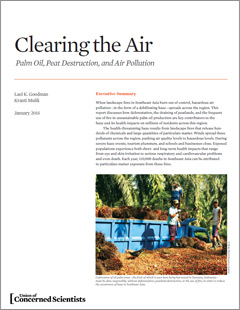Each year in Southeast Asia, landscape fires burn out of control, spreading a debilitating haze across the region. This air pollution causes severe damage to human health, claiming over a hundred thousand lives a year—and if current trends continue, it is likely to get worse.
A 2015 UCS report, Clearing the Air: Palm Oil, Peat Destruction, and Air Pollution, explains the role of deforestation and the use of fire for agricultural purposes in producing the deadly haze. The report shows how increasing demand for deforestation- and peat-free palm oil—also important to slow climate change and protect endangered species—can help reduce the incidence of landscape fires and their devastating health impacts.




